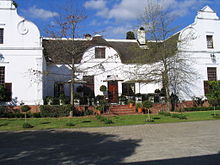Cape Dutch architecture


The Cape Dutch architecture was created with the arrival of Dutch settlers in the Western Cape in present-day South Africa in the mid-17th century. Around 1850 it was replaced by other architectural styles . Many Cape Dutch houses are listed buildings .
Expressions

Above all representative houses were built in the Cape Dutch style, but also churches. The houses are characterized by an axially symmetrical floor plan, often in a T or H shape. A large gable, elaborately and individually decorated by curves, stands above the centrally located main entrance . There are also gables on the sides, which are usually less complex. The house is whitewashed and has a thatched roof . Bricks were mostly used as building material . In Cape Town , chimneys were not installed due to the risk of fire.
There are usually a few steps leading to the front entrance. Next to the front entrance there are two half-width windows and two or four full-width windows on the outside, mostly lattice windows . Above the entrance there is another full-width window. Behind the entrance is usually the front room ( voorkamer ) with the doors to the wings and other rooms. Behind it is the agterkamer, the living room. The fireplace in the kitchen was open.
Preserved Cape Dutch houses can be found along the Wine Route as well as in Stellenbosch , Swellendam , Tulbagh and Graaff-Reinet . Many wineries advertise their products with pictures of the houses. The Tuynhuys in Cape Town, which was restored from 1968 in the Cape Dutch style, serves as the residence of the South African President. In 2013 there were still around 400 Cape Dutch buildings.
history
In 1652 the first Dutch settlers around Jan van Riebeeck arrived at the Cape of Good Hope . The first city to be founded was Cape Town, where the first houses in the Cape Dutch style were built. They were characterized by their kinship with the Dutch architecture of the time, but also took on influences from Germany, France and Indonesia .
Initially the houses were mostly one-story and usually had three rooms. The walls were built from clay or rubble stone . The soil mostly consisted of tamped earth or slabs of slate from Robben Island . At the beginning of the 18th century, larger houses were built, which for the first time had the typical front gables. Slaves abducted from Indonesia and Malaysia were responsible for erecting the gables . The walls were now built from bricks. From around 1750, new U-shaped houses were built, and the T-shape with the kitchen at the end of the wing was also common. Later, larger H-shaped houses were also built. Only a few master builders are known by name, including the Frenchman Louis Michel Thibault and the Germans Anton Anreith and Herman Schutte (1761–1844).
In 1806 the Cape Colony came into British possession, but the architectural style was retained for the time being. The style of construction changed around 1840, because it was possible to draw in central longitudinal walls for the first time and the risk of fire suggested other forms of construction. Around 1850 there was a turn to Victorian architecture . In Cape Town in particular, many traditional settler houses were demolished in the course of urbanization.
literature
- Phillida Brooke Simons, Alain Proust: Cape Dutch Houses and other old favorites. Fernwood Press, Cape Town 2001, ISBN 978-1874950479
- C. de Bosdari: Cape Dutch Houses & Farms. Their Architecture & History. Together with a Note on the Role of Cecil John Rhodes in their Preservation. AA Balkema, Cape Town / Amsterdam 1953
Web links
- Description and historical background at elegantplaces.co.za (English)
- Description and pictures at encounter.co.za (English)
Individual evidence
- ↑ a b c d e f Description and photos at encounter.co.za ( Memento of the original from June 18, 2006 in the Internet Archive ) Info: The archive link has been inserted automatically and has not yet been checked. Please check the original and archive link according to the instructions and then remove this notice. (English), accessed November 30, 2013
- ↑ a b c d Description and historical background at elegantplaces.co.za ( Memento of the original from January 13, 2014 in the Internet Archive ) Info: The archive link was inserted automatically and has not yet been checked. Please check the original and archive link according to the instructions and then remove this notice. (English), accessed December 1, 2013
- ↑ Afrikaans community 1652–1795 at sahistory.org.za (English), accessed on August 5, 2018
- ↑ Herman Schutte at artefacts.co.za (English), accessed on August 5, 2018

